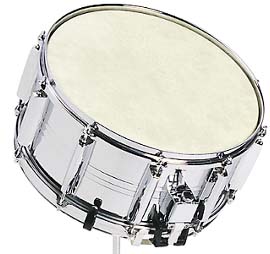
| Snare DrumDrums make use of circular membranes which have many modes of vibration. The excitation of the various modes depends upon where the drum is struck. The timpani is struck near the side to excite certain preferred modes. By contrast, the snare drum is struck in the center and excites the 01, 02, 03, modes. The fundamental frequency for an ideal circular membrane with no air damping effects is given by  |
The snare drum is a two-headed drum, as is the bass drum and other orchestral and band drums used in Western music. On the snare drum, eight to ten wire-bound gut strings, or snares, usually are stretched across the lower of the two heads; they vibrate against the heads as the membranes are struck.
The two membranes of the snare drum are acoustically coupled to each other, particularly at the low frequencies. This coupling via the enclosed air acts to double the modes. The lower frequency member of the mode pair involves both heads moving in the same direction and for the higher mode they move oppositely.
Note that the value of the constant in the above equation for the frequency assumes that MKS units are used, as in the calculation for the circular membrane.
Percussion instruments
Musical instruments
| HyperPhysics***** Sound | R Nave |